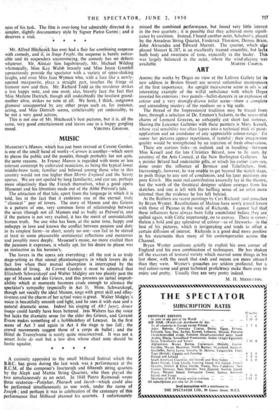ART
AMONG the works by Degas on view at the Lerevre Gallery (at its new address in Bruton Street) are several unfamiliar masterpieces of the first importance. An upright race-course scene in oils is an interesting example of the wilful unbalance with which Degas invested his exteriors ; two pastels—ballet-dancers in an explosion of colour and a very strongly-drawn toilet scene—show a complete and astonishing mastery of the medium on a big scale.
The thread of the Impressionist tradition may be traced from here, through a selection of Dr. Emmon's Sickerts, to the uneveitful charm of Leonard Greaves, so unhappily cut short last summer. Sharing .the Leicester Galleries with these painters is Mary Kessell, whose real sensibility too often lapses into a technical trick of paint- application and an avoidance of any appreciable colour-range. • En masse her pictures appear repetitious, if tasteful ; their imaginative quality would be strengthened by an injection of fresh observation.
There are curious links—in outlook and in handling—between Miss Kessell and the late Christian Berard, now to be seen,.,ky courtesy of the Arts Council, at the New Burlington Galleries As a painter Berard had undeniable gifts, at which his earlier canvases, done under the influence of Berman and Tchelitchew, hint. Increasingly, however, he was unable to get beyond the sketch stage, to push things to any sort of conclusion,•and his later paintings are pure Kitsch. His most real contribution assuredly lay in the theatre, but the worth of the theatrical designer seldom emerges from his sketches, and one is left with the baffling sense of an artist more talented than, the evidence he has left behind.
At the Redfern are recent paintings by Ceri Richard:- and gouaches by Bryan Wynter. Recollections of Matisse have newly joined forces with those of Picasso in the work of Richards. I cannot feel that these influences have always been fully assimilated before they are spilled again, with Celtic impetuosity, on to canvas. There is never-; theless a bold and gay splendour of colour—as of fireworks—in they best of his pictures, which is invigorating and tends to offset a certain diffusion of interest. Richards is a good deal more positive in his statements than many of his contemporaries across the Channel.
Bryan Wynter continues quietly to exploit his own corner of England and his own combination of techniques. He has shaken off the excesses of textural variety which marred some things in his last show, with the result that ends and means are more attuned than they were. Wynter's gouaches are seldom profound, but a real colour-sense and great technical proficiency make them easy to enjoy and pretty. Usually they are very pretty indeed.
M. H. MIDDI ETON.


































 Previous page
Previous page